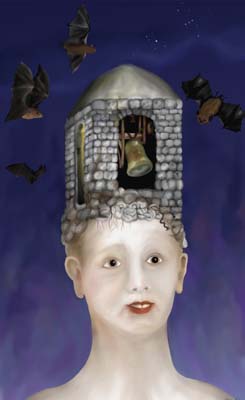When students in this country begin writing in college, they are likely to become aware of some bad writing habits they've picked up. This may be because whatever high school they attended did not enforce good writing habits, or they failed to take good pieces of advice seriously. Face it--senior year we all just want to get the f-- out of there. Understandably.
However, good writing is not just valuable for pleasing a professor. Consider the reason we attend school at all. It is to learn, to improve, to expand consciousness and examine up close the canon of information and intelligence we have inherited. And once we have done this, we are invited to apply our talents in the outside world, that is, beyond the classroom.
But still many students fail to see how good writing habits are connected to their particular field of study. What, for example, does proper comma usage have to do with politics, math, or business?
Consider this sentence: "The candidate owing to some scandal has dropped out of the race."
Without the comma bracketing the absolute phrase "owing to some scandal," a reader may first be confused by the phrase "The candidate owing." It is not clear, with the form "owing" if that is the verb following the subject, "the candidate," or if it is the start of an egregious sentence fragment. Then although logically we know that scandals do not have the power to drop out of anything, it is confusing to see "some scandal has dropped out of the race." We may have to read the sentence a couple times before we realize that some punctuation is missing, obscuring meaning. And after all, isn't that the point of writing, to communicate meaning?
 |
| Read more, write better. |
Again, you may say, logically no reader would assume these errors are literal. But then we come to the true goal of writing: communicating meaning quickly and simply. We cannot use ESP, so we are obliged to spell it out. We do not want our readers having to spend time reading a sentence twice for a meaning that is quite simple. We do want them to be propelled to the next sentence as we lead them through a path of thought.
Remember also that you are being judged for your writing skills. How you write says a lot about you as a thinker. Do you skip steps in logic? Do you fail to address contradicting points of view? Do you ignore your reader, or disrespect him/her by obscuring your meaning with inflated structure? Good writing could literally mean the difference between getting the job or not, winning a grant/fellowship/spot on the board, or winning the girl/guy. I get asked all the time: what's the best and quickest way to become a better writer? And I respond:
"READ."
I have been a writing tutor now nearly four years, working with students both undergrad and graduate, both native English-speaking and otherwise, and I have found that there are a number of very common misunderstandings about written expression. Many students after my sessions have asked for a business card. As I am employed through the college, and have little outside time, I don't have such a trinket. I do, however, have this forum where I can maybe try to compile and address a few of these standards and why they are worth following.
I will start with the beginning of any writing assignment:
Pre-Writing
 A misnomer. It involves writing too. Our heads contain an impressive sandstorm of thoughts, ideas, intuition, distractions, and embedded cultural norms as well as leftover primal patterns. When we are concentrating on a particular subject, the thought filaments are flying around like bats out of hell, and the only way to pin them down is to drag them out and slap 'em on paper. They suddenly appear before us in all their simple glory, isolated from the clusterfuck that is our brain.
A misnomer. It involves writing too. Our heads contain an impressive sandstorm of thoughts, ideas, intuition, distractions, and embedded cultural norms as well as leftover primal patterns. When we are concentrating on a particular subject, the thought filaments are flying around like bats out of hell, and the only way to pin them down is to drag them out and slap 'em on paper. They suddenly appear before us in all their simple glory, isolated from the clusterfuck that is our brain.
Once we look at an idea, several more pop up in us. Drag 'em out, pin 'em down. Look at the two ideas you've just written. How are they related? Does one support the other? Is it a more specific part of the first idea? Does it refute the first thought?
There are dozens of ways to organize a brainstorm session. I find myself organizing differently based on the ideas, the assignment, whatever. Some topics are going to be more complex than others, and I say the more complex the ideas, the simpler your outline should be. I have found the following outline structures to be helpful in different situations:
1. Traditional hierarchical outline:
-->
OUTLINE TITLE
Introduction
I
The first sub-topic
n A. First supporting information for the
sub-topic
n B. Second supporting information for the
sub-topic
n C. Second supporting information for the
sub-topic
II The second
sub-topic
n A. First supporting information for the
sub-topic
n B. Second supporting information for the
sub-topic
n C. Second supporting information for the
sub-topic
III The third
sub-topic
n A. First supporting information for the
sub-topic
n B. Second supporting information for the
sub-topic
n C. Second supporting information for the
sub-topic
IV The fourth
sub-topic
n A. First supporting information for the
sub-topic
n B. Second supporting information for the
sub-topic
n C. Second supporting information for the
sub-topic
V The fifth
sub-topic
n A. First supporting information for the
sub-topic
n B. Second supporting information for the
sub-topic
n C. Second supporting information for the
sub-topic
conclusion:
Type
conclusion notes on this page.
Checklist For Writing an Outline
Organization
The introduction states the main topic or idea of the outline.
Each paragraph in your paper has a sub-topic.
Each sub-topic describes the main idea for a paragraph.
Supporting information and details for a sub-topic are listed under the
sub-topic
Each piece of supporting information is listed separately.
When supporting information is listed under a sub-topic, there are at
least two pieces of information in the list. If there is only one piece of
information to support a sub-topic, the information is inlcuded in the
sub-topic.
The conclusion summarizes the main idea of the outline.
(Note that this outline contains more sections than the old 5-Paragraph Essay you learned in middle/high school. When you get to college you can remove the training wheels.)
The advantages to this form of outline is that you remember to order the more general ideas first and the specific aspects of those ideas second:
---> Can be used for tracking multiple possible outcomes of your ideas. For example, if we assume the green light at Daisy's property in The Great Gatsby represents money, then we could assume that by staring obsessively at it, Gatsby's desire for her is linked to his desire for money. However, if we assume it is the green of youth, naivete and carelessness, then perhaps his desire for her is linked to his desire for youth. By examining each of the possibilities, boom--you have multiple subtopics to address and examine in your paper, filling up not only space in the paper you were supposed to hand in yesterday, but also demonstrating thoroughness of thought.
3. Venn Diagram (good for a comparative essay, good for the visually-oriented)
4. Spider graph
You want your outline to be easily read--by YOU! So however you can read and then re-decipher your thoughts when you return to the outline is up to you. Most professors never ask to see this (unless you're in an academic writing class), so you can even use pictures if you think that way.
If you know you have trouble thinking and writing at the same time, consider finding a friend or visiting your friendly Writing Center for a tutor to help you with this. Remember that if you do consult a tutor, they are helping you do your work, not doing it for you. You are the expert on your subject because you've been taking the class. Bring all your materials from class, a copy of the assignment sheet, and a positive attitude.
This stage in writing is very important, because you are able to interact messily with your ideas as they form together, instead of trying to do this simultaneously in full, complete, grammatically correct sentences. Even if you are adept with writing assignments, this strategy will allow you to appraise the organization and logical flow of your ideas before you begin brilliantly cataloging them in sentence form.
Happy outlining! :)









